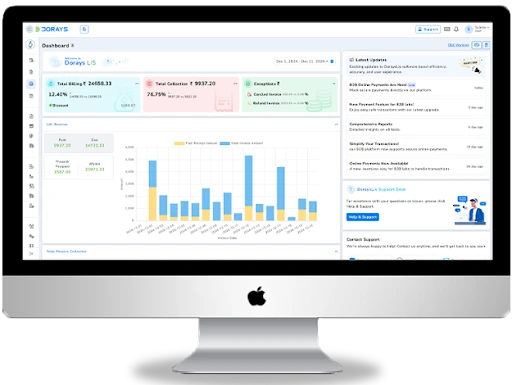Pathology
The integration of Artificial Intelligence (AI) into medical diagnostics is reshaping the healthcare industry, and digital pathology is no exception. By combining high-resolution image analysis with advanced algorithms, AI is bringing unparalleled improvements in diagnostic accuracy and efficiency. But how exactly is AI transforming digital pathology, and what does the future hold for this innovative technology?
This comprehensive guide will unpack the benefits of AI in digital pathology, including its impact on accuracy, speed, and lab efficiency, as well as explore the challenges that must be navigated to fully integrate AI into medical diagnostics.
How AI is Redefining Digital Pathology
What is Digital Pathology?
Digital pathology involves capturing, analysing, and interpreting pathology slides and tissue samples digitally. Traditionally, pathologists rely on microscopes to examine slides, which is a time-intensive and labour-intensive process. Digital scanners, however, allow these slides to be converted into high-resolution images, enabling remote analysis and collaboration.
Now, with the addition of AI capabilities, digital pathology is taking a huge leap forward. AI algorithms are able to identify patterns, detect abnormalities, and interpret data in ways that go far beyond human capabilities, bringing new levels of precision and efficiency.
Why is AI Important in Medical Diagnostics?
Medical diagnostics often require a balance between speed and accuracy. While human expertise remains invaluable, factors like workload, human fatigue, and interpretive variability can affect outcomes. AI overcomes these limitations by providing consistent and objective analysis. Its ability to learn from vast datasets positions it as a critical tool in improving diagnostics and supporting healthcare professionals.
Enhancing Diagnostic Accuracy with AI
One of the most significant contributions of AI in digital pathology is its ability to improve diagnostic accuracy.
How AI Eliminates Errors
AI algorithms are trained on extensive datasets of pathology images to identify patterns that may be difficult for the human eye to detect. For example, machines can analyse tumour margins, grade cancer stages, and identify cell abnormalities with high precision. Tools powered by AI can flag suspicious areas, prompting pathologists to take a closer look while reducing instances of oversight.
Real-World Applications
An example of AI enhancing diagnostic performance is its application in skin cancer diagnostics. Research has shown that some AI algorithms are better than dermatologists at identifying malignant melanomas. Similarly, in breast cancer pathology, AI has been utilised to evaluate HER2 status, significantly improving consistency between pathologists.
For conditions that require complex assessments, such as rare cancers or intricate tissue structures, the margin for human error is higher; AI algorithms act as a safeguard to ensure nothing is overlooked.
How AI Speeds Up Diagnoses
Faster Turnaround Times
Time is vital in pathology, especially when quick action can dramatically affect patient outcomes. With AI-powered systems, diagnostic turnaround times are significantly reduced. Tasks that may take pathologists hours, or even days, can be streamlined into minutes.
For instance, AI can pre-screen slides, highlighting areas for pathologists to investigate rather than requiring them to painstakingly review every section themselves. This not only accelerates the process but allows pathologists to focus their expertise where it’s needed most.
Case Studies
- Breast Cancer Screening: Studies have showcased AI’s ability to handle larger volumes of mammogram screenings, effectively reducing backlogs in hospitals.
- Lung Pathologies: AI applications have demonstrated their ability to instantaneously identify abnormalities in lung scans, leading to earlier intervention and improved treatment outcomes.
Key Benefits of AI in Digital Pathology
The combination of faster turnaround and higher accuracy brings numerous advantages across the healthcare pipeline.
AI reduces the manual workload for pathologists, enabling labs to process an increased volume of cases without compromising quality.
- Enhanced Diagnostic Precision
By harnessing AI, digital pathology achieves new levels of consistency, ensuring that every detail is accounted for.
Timely diagnoses often translate to more effective treatments. Faster AI-powered diagnostics mean patients can receive critical interventions without unnecessary delays.
Challenges in Adopting AI in Digital Pathology
While the benefits are impressive, implementing AI into digital pathology comes with its challenges that organisations must address to succeed.
Data Privacy and Security
Handling sensitive patient data raises significant privacy concerns. AI relies on extensive datasets, often needing access to thousands of patient samples to train its algorithms. Ensuring compliance with stringent data protection regulations, such as GDPR, is crucial for gaining trust within the healthcare community.
Standardisation
Currently, there’s a lack of industry-wide protocols for digital pathology. From imaging formats to training datasets, inconsistencies pose a hurdle for seamless AI adoption. Developing common standards is vital for ensuring AI tools work cohesively across systems and labs.
Overcoming Resistance Among Professionals
AI is sometimes perceived as a disruptive force, sparking fears of redundancy among pathology professionals. For successful integration, organisations must focus on education and training to show how AI should be viewed as a partner to human expertise rather than a replacement.
The Future of AI in Digital Pathology
AI’s impact on digital pathology is only just beginning. With continuous advancements in machine learning, neural networks, and computational capabilities, the future holds immense potential. Real-time AI diagnostics, predictive analytics for personalised treatment plans, and even preventive healthcare measures are all within reach.
By addressing challenges today, organisations can position themselves at the forefront of what promises to be the next major revolution in medical diagnostics.
Take Action
Digital pathology is set to transform healthcare with the power of AI. The path towards unparalleled accuracy and efficiency starts with understanding how to implement these tools effectively. If your organisation wants to gain a competitive edge in diagnostics, the time to act is now.
Explore cutting-edge platforms like LabWare LIMS and Thermo Fisher SampleManager LIMS to bring seamless integration to your labs. Stay ahead of the curve and partner with technology to deliver remarkable healthcare outcomes.

